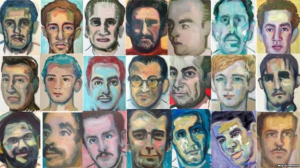26-year-old Nelson Rodríguez Leiva was executed in the La Cabaña fortress in 1971. The same fate awaited his soulmate friend, Angelito de Jesús Rabí. A century earlier, the poet Juan Clemente Zenea was shot dead at the same place.

It was of no help that Nelson was a teacher who conducted a literacy mission in the mountains of the El Oriente province in 1961, or that he was an excellent writer who had a book of stories published by the prestigious Ediciones R. publishing house with the help of the writer Virgilio Piñera in 1964. His mother, Ada Leiva, made a written appeal to Fidel Castro, asking the Cuban leader to grant a pardon to her son, but there was nothing that anybody could do to save Nelson.
Just a few weeks ago, The Miami Herald published an extensive report on an exhibition by the Cuban writer and artist Juan Abreu where a hundred portraits of Cubans executed by the Castro regime’s firing squads were on display, including that of Nelson’s. The exhibition was held at the European Parliament’s headquarters in Brussels.
Abreu earned praise from former political prisoners such as Pedro Corso, director of the Cuban Institute of Historical Memory against Totalitarianism, and from the poet Ángel Cuadra, who believes that the exhibition of Abreu’s work is “a way of letting the history speak through the faces, an attempt to rescue them and give them a new life.” Most likely, Abreu would have also received support of his dearest friend, writer Reinaldo Arenas, if he was still alive.
“These are not conventional portraits, but rather an attempt to focus on the faces on old photos, often blurred,” said Abreu.
The fact that Abreu’s project reached the premises of the European Parliament must be seen as a great success. It is an attempt to preserve that part of the Cuban history which the government, currently in the hands of Raúl Castro, wants to erase.
It’s a fact. The execution of five thousand people hangs over Cuba like the Sword of Damocles and their spirit lives on in the La Cabaña fortress. No matter how many parties the murderous government holds there, no matter how much hustle and bustle people coming to the fortress make, how much fun and mess there is, no matter how many books are sold at annual book fairs that are hosted there, the sad legacy can still be felt.
The two young writers, Nelson and Angelito, ended up in the fortress, tied up, blindfolded, so as not to see the rifles in the night. They died together, as they wanted.
Not long ago, someone who knew them told me that Nelson was very romantic, that he used to weep when listening to the songs by the Beatles. They said he even looked a bit like James Dean! Angelito, his noble page, had a face of a child, even at the time of his death.
Blissfully ignorant of the history of the La Cabaña fortress, many Cubans now regularly wander through the same sad alleys which lead Nelson and his friend to the place of their death.

Leave a comment